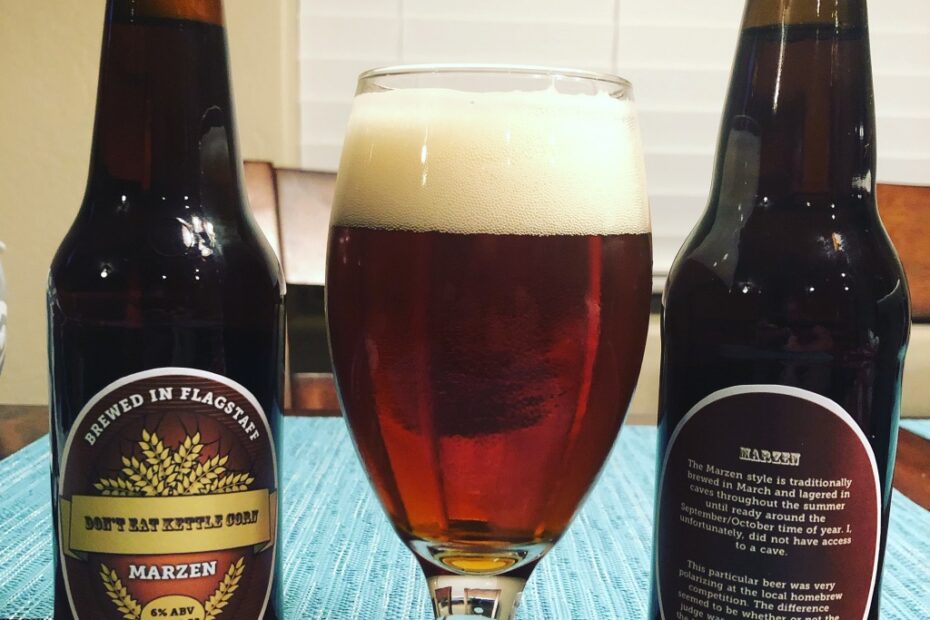Oktoberfest may be canceled this year, but that doesn’t mean you can’t enjoy your own homebrewed example of this wonderful german lager! In this post, I’ll outline my Oktoberfest/Märzen BIAB recipe (2.5 gallon).
What is an Oktoberfest?
An Oktoberfest beer fits into the Vienna lager category. This category encompasses amber colored beers that are fermented with bottom-fermenting lager yeasts. The Märzen is another name for a beer in this category. Both Märzen and Oktoberfest beers are generally stronger gravity beers than the standard Vienna lager, and they were both brewed for the festivals that happened in October every year (besides 2020). The Märzen name stems from the german word for March (März) as this beer was typically brewed in March, then lagered in caves until it was ready for the festival in October.
A Märzen or Oktoberfest should be amber in color, sport a malty complexity, and show elegance in both flavor and aroma.
If you have interest in learning more about this style, I highly recommend this book. As with many styles that I brew, I like to read as much as I can while developing my recipe. This book gives you a solid history on the style as well as many tips on brewing it.
With this particular beer, I tried to pull all relevant info from the book linked to above, and create a recipe based on the finest points presented in the book. I hope you enjoy this elegant lager as much as I have!
Oktoberfest vs Märzen
Given what I have read on the matter, the beers by the name of Oktoberfest and Märzen are synonymous. They are differentiated from standard Vienna lagers in strength, however.
So, you can think of this recipe as a Märzen BIAB recipe as well!
If you would like to read more on the BJCP description on this beer (6A), please follow this link.
How to Warm Ferment Lager:
It is worth noting that as with my recent doppelbock, this beer was also a warm-fermented lager. Meaning that it was not fermented at standard lagering temperatures (45-55F), and instead fermented at room temperature of my house (about 65F). This method requires much less equipment, and I have had good results on several occasions using this method.
If you’re interested in learning more about the warm-fermented lager technique, click here! Some may call this a ‘pseudo-lager’, but I feel that as long as the quality of the end product is sound, that’s what matters most!
This method can also be useful in making a lager more quickly, which can be helpful if you want to have a beer ready by late September or early October!
Stats:
Volume: 2.5 gallons
Predicted SRM 11.46
Predicted IBU 24.52
Original Gravity 1.062
Final Gravity 1.016
ABV- 6.11%
Grain:
4.5lb oz Pilsen Light (1.2L)
1lb Vienna Malt
10oz Caramunich (49L)
5oz Melanoidin (25L)
2oz Carapils
Strike water 162F, mash started at 154
Hops:
0.3oz Tettnanger (45 min)
0.5 oz Hallertau Mittelfruh (30 minutes)
0.5oz Saaz (10 minutes)
Other Additions:
Irish Moss (10 minutes)
Water:
Local Flagstaff Tap Water
1/4 tsp of CaCl
Mash pH 5.6
3 gallon boil (60 minute boil)
Yeast:
Saflager 34/70 (1 packet)
Directions:
Mill the grains and mix with 2.75-3 gallons of 162°F strike water to reach a mash temperature of 154°F. Hold this temperature for 60 minutes. Sparge the grains with 170°F water until you reach a volume of 3 gallons of wort. Boil for 60 minutes, following the hop schedule. Add Irish moss at 10 minutes.
After the boil, chill the wort to slightly below fermentation temperature, about 64°F. Aerate the wort and pitch the yeast. Ferment at 65°F (18°C) for 2-3 weeks, then cold crash the beer to 35°F. Bottle or keg the beer and carbonate to approximately 2.25 volumes of CO2.
Tips:
Clarifying Agents:
As this particular beer was warm fermented, it does not have the natural clarity advantage that true lagering provides. Time alone can do wonders for the clarity of a beer, but if you are looking for other agents, gelatin and Biofine Clear work well. However, keep in mind that if you are brewing a beer for any vegan or vegetarian consumers, gelatin will not fit the bill. Biofine Clear on the other hand is colloidal silicon dioxide and is vegan friendly.
With this particular beer, I used Biofine Clear first, and then two days later used Gelatin with great results!
Thank you for stopping by!
If you are interested in how to homebrew using the brew-in-a-bag BIAB method, please see my post here.
If you would like to see more small batch recipes like this, please follow this link.
Resources: Vienna-Marzen-Oktoberfest by George and Laurie Fix
